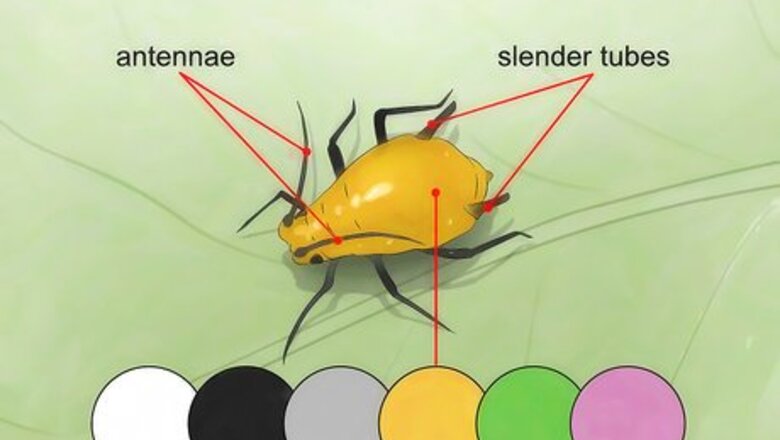
views
Remove small clusters of aphids by hand, and try selective pruning or homemade organic repellent sprays for a more lasting effect. Once they're gone, introduce beneficial new plant and insect species to your garden to discourage any pests that might be waiting in the wings from returning with a vengeance.
Identifying Aphids

Learn to recognize aphids by sight. The tiny insects have rounded bodies, with long antennae and 2 slender tubes extending from either side of their rear end. Depending on the species, they may be white, black, gray, green, yellow, or even pink. Some types appear to be covered with a fuzzy, cotton-like substance when viewed up close. There are both flying and wingless species of aphids, making them even more of a nuisance to control. Some will grow wings once their current food source is degraded and fly onto greener pastures. Aphids are a common pest in all parts of the globe, and have been known to infest almost any type of crop, tree, shrub, or flowering plant.
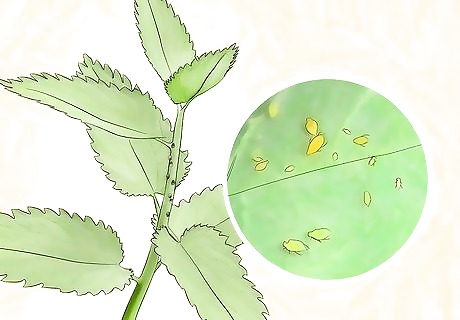
Inspect the underside of your plants' leaves for the insects. Turn the leaves over and examine them closely to catch aphids in the act. Though small, they're typically visible to the naked eye. There's no better evidence that you have an aphid infestation on your hands than seeing them for yourself. While aphids prefer to make a meal of the succulent leaves of fruits and vegetables, they'll happily feed on whatever they find growing. Even a small population of aphids can present a major problem for farmers and gardeners.
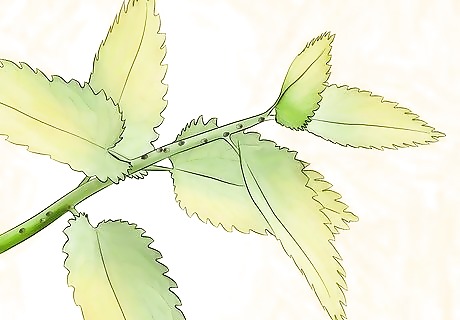
Pay attention to curled or discolored foliage. Take note anytime your plants appear to be failing inexplicably. After long enough, the activity of hungry aphids can weaken or spread disease in once-healthy plants, causing them to look sickly. Along with the more obvious symptoms of disease, you may be able to spot tiny bite marks along the edges or veins of the leaves. Aphids tend to flourish during the warmer summer months.
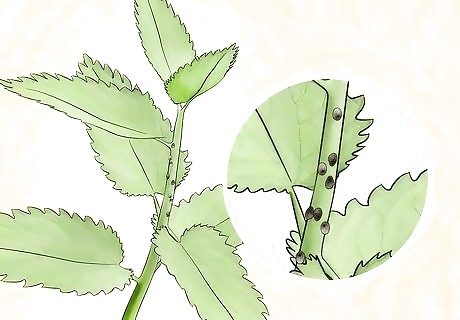
Look for the presence of honeydew to see where aphids are feeding. When aphids eat the sap of healthy plants, they excrete a sticky substance known as “honeydew.” If the leaves of your plants are unusually slick and shiny, or seem to be covered in a thin mucus-like material, there's a good chance that there are aphids nearby. Honeydew can also take on a dark brown or black coloration as mold and fungi begin to grow on it. Hosing off your affected plants periodically will help wash away not only aphids themselves, but the residue they leave behind.
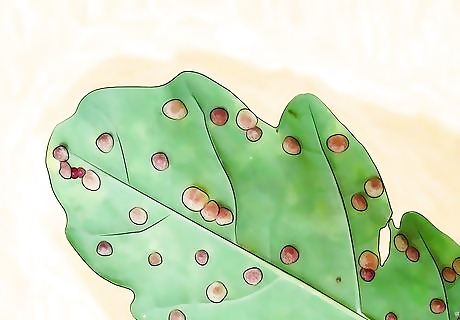
Keep an eye out for plant galls. Once every couple weeks, scan the plants in your garden from root to tip to look for galls. Galls are sites of swelling or abnormal growth that pop up on the outer surface of infested plants. They most often appear as a result of irritation due to insects like aphids feeding and laying eggs. Galls may be accompanied by severe discoloration, making them look like dark raised bumps or mold spots. If left untreated, galls may leave the plant vulnerable to more serious diseases.
Removing Aphids Manually
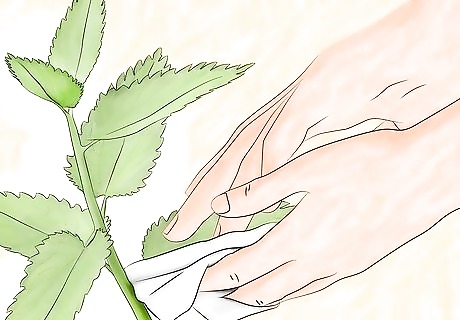
Pick off small numbers of aphids by hand. Pluck stray insects from the leaves of affected plants and crush them between your fingers. Aphids have soft bodies, which make them easy to dispatch with a single squeeze. If you're dealing with more than about half a dozen, it may be easier to use a damp paper towel to wipe them away. Always wear gloves when removing aphids by hand to protect your skin from potential irritants. While aphids usually migrate and feed in colonies, they can also appear 1 or 2 at a time.
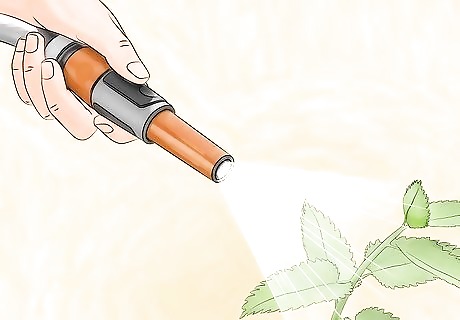
Spray the leaves of infested plants with a garden hose. A forceful stream of water should be enough to dislodge stubborn pests. Direct the stream toward the underside of the leaves, where aphids tend to congregate. Hose down your plants 1-2 times a day until the infestation starts to thin out. Avoid using a pressure setting high enough to damage the plant itself and refrain from overwatering. Regular spraying is most effective for combating small-moderate infestations on hearty, established plants. Allow the leaves to dry completely between waterings. Wet foliage increases the risk of diseases like blight and rust in plants that are sensitive to moisture.
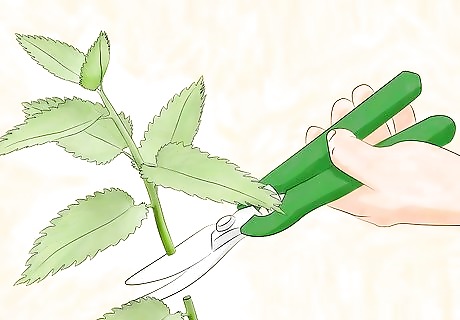
Cut back the plant to eliminate large colonies. Trim heavily-infested sections where the greatest number of aphids are concentrated. This may involve plucking leaves or fruits, clipping stems, or even removing whole branches. Check to make sure you haven't overlooked any insects on other parts of the plant. After cutting back the affected plant, douse it thoroughly with water or a homemade aphid repellent solution, such as those enumerated here. Selective pruning works best when aphids are confined to one specific section of the plant.
Using Repellents and Pesticides
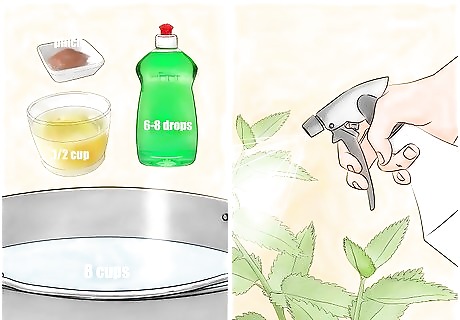
Mix up a homemade soap solution. Combine 2-3 teaspoons (10-15 mL) of mild liquid dish soap with a few ounces of warm water in a spray bottle and shake well. Apply the solution liberally to plants that shows signs of aphid activity. The surfactants in the soap will eventually cause the insects to dry out without affecting the plant. To make your solution even more effective, add a generous pinch of cayenne pepper. Keep your spray bottle in a garage or shed near your garden so you'll always have it when you need it. This solution will kill beneficial insects, too, so try to be selective when spraying plants. Mixing up a fresh batch for each application will keep your spray nozzle from clogging.
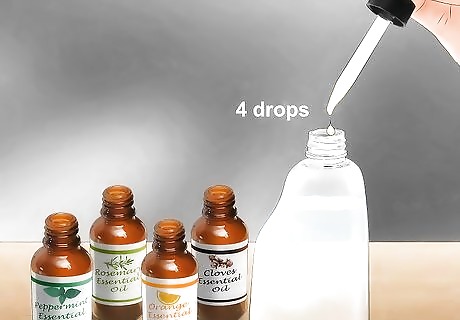
Try a blend of essential oils. Add 4-5 drops of rosemary, clove, cedar, orange, or peppermint oil (or create your own blend of each) to a spray bottle filled with water. Mist your infested plants from leaf to root. Essential oils are naturally repulsive to aphids, so whatever bugs the mixture doesn't kill off will be in a hurry to leave. Not only are essential oils complete safe, they'll also pull double duty as a pleasantly fragrant insect repellent. Always dilute your oil mixtures, as excessive oil left on leaves can burn your plant. Designate one spray bottle for this use, as the oil will permeate the bottle.
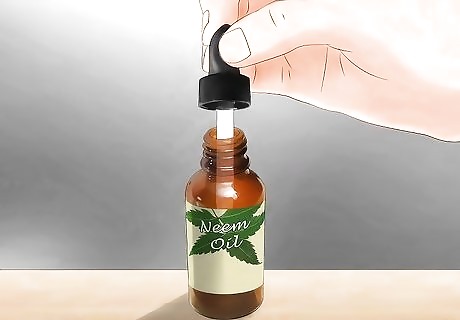
Purchase a bottle of neem oil. Neem oil is a plant-based oil compound that's useful for controlling aphids. You can get neem oil in its pure form, then dilute it with water to make a 2% solution and spray wherever you find unwanted insects. The cloying oil will smother the aphids, killing them in a matter of hours. Neem oil can be found at any major gardening center. It's nontoxic and breaks down rapidly once it's exposed to air, so it won't harm you or your plants. As an added bonus, neem oil is also useful against a host of other common pests, including mealy bugs, beetles, and caterpillars. That said, it will kill beneficial insects as well as pests, so try to be selective when you spray.

Spritz your plants with an insecticidal soap. Like neem oil and other natural pesticides, insecticidal soaps are used to suffocate aphids. These products are available at most greenhouses, plant nurseries, and outdoor supply stores. They typically come premixed, which means you won't have to worry about doing a lot of measuring. Insecticidal soaps can be toxic to certain types of plants, so be sure to read the recommended use information on the packaging carefully before applying them in your garden.
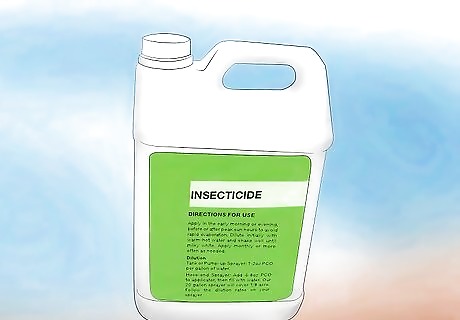
Use commercial insecticides as a last resort. If none of your other efforts have worked, or you're dealing with a full-scale invasion, it may be necessary to try a more potent pesticide. Look for products proven to be effective against aphids. Some pesticides are sold in convenient spray bottles, while others will need to be mixed and deployed using a chemical sprayer. Keep in mind that chemical insecticides can be damaging to plants and beneficial predator species. Always follow the instructions provided on the product label, and never use more than directed. The National Sustainable Agriculture Information Service (ATTRA) has compiled a database of low-risk pesticides that may benefit farmers and gardeners, including many botanical options.
Preventing Future Infestations
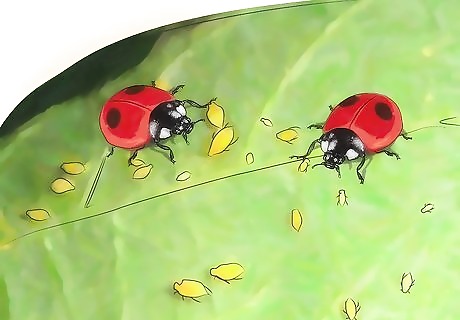
Introduce beneficial insect species to your garden. Ladybugs, hoverflies, and green lacewings are just a few insects that prey on aphids. When added strategically to your garden, they'll help reduce populations of more destructive pests and restore order to areas that have been damaged by infestation. You can typically purchase the eggs, larvae, and even live specimens of helpful garden predators at major garden supply stores. Ladybugs and lacewings and can become a nuisance in their own right. When pitting insect against insect, bring in a modest number and keep a close eye on them so you're not just trading one pest for another.

Choose plants that attract ladybugs. Make room for a few of the critter's favorites, like geraniums, Sweet Alyssum, sunflower, Queen Anne's Lace, and parsley. With the right offerings, you can draw helpful ladybugs to your garden without going to the trouble of buying, releasing, and monitoring them on your own. Think twice before pulling out every last weed you find. Leaving a few here and there will help promote diversity in your growing space, and varieties like dandelion and bugleweed are actually attractive to some species of ladybugs. Provide a source of water, such as an active sprinkler system, small fountain, or bird feeder, to ensure that the ladybugs have all their needs met. Place a small rock in the center, so insects have a way to climb out and avoid accidental drowning.
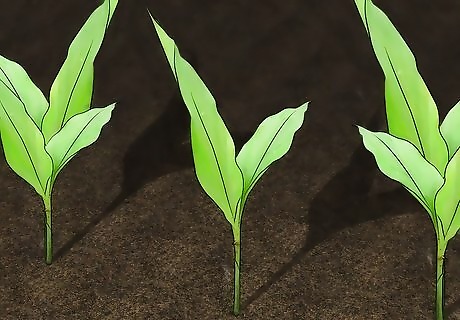
Use aromatic plants as a deterrent. Grow alliums like onions and garlic, as well as other smelly plants such as ginger root, oregano, and sage, around plants that tend to become overrun by aphids. Their pungent odors are offensive to the insects, who will eventually move on to a different setting in order to get away from it. If you're looking for a quicker solution, you can also cut up fresh alliums and scatter them over the perimeter of your garden rather than taking the time to cultivate them.
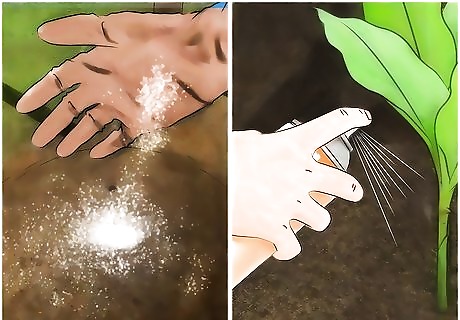
Destroy any ant colonies you come across. Wipe out swarms of unwanted ants using a commercial ant killer and destroy their hills or nests to keep them from returning. Ants target many of the insects that feed on aphids, meaning the more of them there are around, the longer your aphid problem is likely to continue. Ants have also been known to protect and herd aphids in order to use their natural secretions as a food source.



















Comments
0 comment